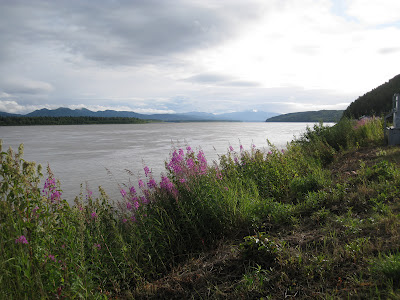A Lesson Plant for Gardening in the Classrooms of Alaska, By Mylinda A. Klein, an Alaskan Master Gardener
 |
| Snap Beans. Photo by Heidi Rader. |
Subject Area: Science
Grade Level: 2nd grade
Ideal season for lesson: Fall
Materials Required:
Various seeds either collected by teacher or by students
including an acorn and seeds that have a spine, hooks or a gooey
coating.
Chipmunk stuffed animal
“Seeds: Pop-Stick-Glide’ by Patricia Lauber
Chatty Chipmunk’s Nutty Day bySuzanne Gruber
Goals and Outcomes
Students will be able to identify at least three methods of seed dispersal.
Introduction
Most seed-bearing plants have developed a way to disperse seeds away from the parent plant, giving the new plant a better chance to find what it needs to grow.
Wind: Some plants rely on wind for seed dispersal. They produce very light seeds with sail-like or hairy outgrowths that enable them to be carried by the wind. For example, the double winged maple seed (called a samara) has papery wings that twirl like a helicopter, while a dandelion seed has a fuzzy “parachute’ that carries it on air currents. Orchid seeds are so tiny that they float in the air like particles of dust.
Animals: Many plants depend on animals to disperse their seeds. Some of these, like Queen Anne’s lace and burdock, produce seeds with spines, hooks, or gooey coatings that catch on a n animal’s fur or people’s clothing and are carried to distant places. Other plants, like peaches, apples, and raspberries develop seed within an attractive, tasty fruit. Those seeds are eaten by animals, carried in the animals’ digestive systems, and deposited in a different location when the animal defecates. Still other plants, like acorns and walnuts have attractive nuts that animals move to different locations for storage.
Mechanics: Some plants mechanically eject their seeds away from their parent plant. For example, witch hazel seeds develop within a pod that squeezes the seeds as the pod dries. When the seed finally shoot out, they can travel up to 40 feet! Lupines, violets, and bean plants also disperse their seeds this way.
Fire: Still other plants depend on fire for seed dispersal. For these plants, burning prepares an optimal seedbed. A number of pine species around the world have serotinus cones, which are held closed by a resin until there is a fire. At that time, when a critical, high temperature is reached, the resin melts and allows the seeds to be released from the cone. Lodgepole pines and Jack pines disperse their seeds in this way. (Project Learning Tree: Pre K-8 Environmental Education Activity Guide American Forest Foundation 2006-2011)
Water: Some seeds can also be dispersed by bouncing or rolling, and floating on water.
 |
| The Yukon River, from Ruby, Alaska disperses seeds. Photo by Heidi Rader. |
Activity I
Step 1: Read “Chatty Chipmunk’s Nutty Day’ by Suzanne Gruber
Step 2: Have seeds scattered on a plate or tray of varying size and texture.
Step 3: Discuss what seeds Chatty Chipmunk can carry back to his nest. Questions may include:
Why does Chatty want the seeds? (to eat)
What seed do you think Chatty will want to eat? (The acorn)
What seed to you think would be hard for Chatty to carry? (Anything really small or large)
Are there any seeds that Chatty chipmunk may not want? (Anything that is not nutritional)
Step 4: Have Chatty Chipmunk walk through seeds and see if any “stick.’
Step 5: Lead a discussion about how Chatty was able to move the seeds. Pointing out how he carried some for food, while others hitched a ride on his fur. Questions may include:
What other animals eat seeds?
What about bear poop? Has anyone seen scat in the woods?
Can you think of other ways seeds may move?
What about yesterday and “The Tiny Seed?’ How did it move?
Activity II
Read “Seeds: Pop-Stick-Glide’ – Patricia Lauber;
Lead a discussion about any new seed dispersal techniques that were not identified in Activity I.
AK Standards
S.02.03 The student demonstrates an understanding that interactions with the environment provides an opportunity for understanding scientific concepts by
S.02.03.01 observing local conditions that contribute to a healthy ecosystem for local plants and/or animals.
Bibliography
Chatty Chipmunk’s Nutty Day, Suzanne Gruber
Project Learning Tree: Pre K-8 Environmental Education Activity Guide American Forest Foundation 2006-2011
“Seeds: Pop-Stick-Glide,” Patricia Lauber
About Heidi Rader
Twitter •